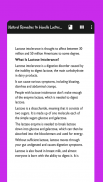Natural Remedies to Handle Lactose Intolerance - Baixar APK para Android | Aptoide





Descrição do Natural Remedies to Handle Lactose Intolerance
Lactose Intolerence is a condition a person has when their body cannot correctly process lactose. Lactose is a milk sugar that is often found in foods made from milk products, such as yoghurt, ice cream and other dairy foods.
When a lactose intolerent person consumes a product containing lactose, their body cannot process the food and this can result in unpleasant symptoms, which commonly include stomach cramping, diarrhea, and flatulence. Depending on the amount of dairy the person consumes and to what degree their body can process lactose, will determine their degree of adverse reaction.
The medical explanation of lactose intolerence is fairly straightforward when lactose and lactase are distinguished. Lactose is milk sugar found in milk products and lactase are the enzymes that aid in digesting lactose. Lactase enzymes can be found on the wall lining of the small intestine. They aid in digesting and absorbing lactose into the body. If lactose cannot be broken down into Glucose, it will sit and ferment in the body creating excess amounts of methane/ hydrogen and water. With these excess amounts in the small intestine, it creates the common lactose intolerent symptoms that include flatulence, stomach cramps, and diarrhea.
There are 3 main causes to why people experience lactose intolerent symptoms. These include congenital, secondary and developmental causes. Congenital (after birth) is caused by a rare condition that involves a mutation of the gene that produces lactase. Lactose intolerent symptoms usually begin to appear soon after birth. The secondary cause of lactose intolerence is the lack of lactase in the small intestine, due wall lining damage by a disease or illness. The third and last cause of lactose intolerent symptoms is called developmental or hypolactasia. This is when the decrease of lactase in the body occurs over time due to the programming of an individual's DNA. The time the decreation begins, the age of first symptoms, can vary throughout different ethnic groups.
The most common symptoms of lactose intolerencelmrummy.in include diarrhea, flatulence, and abdominal pain. The uncommon lactose intolerent symptoms are abdominal bloating, nausea and abdominal distention. The severity of these symptoms is dependent on the amount of lactose consumed and how much lactose the body can tolerate.
There are several tests that can determine and distinguish whether a person has lactose intolerence, a milk allergy or a lactase deficiency. These tests include the milk test, elimination diet, breath test, intestinal biopsy, stool acidity test and the blood glucose test. If a person suspects they have this condition after experiencing lactose intolerent symptoms, the first thing they should do is make sure they have spoken with their doctor before beginning any sort of lactose free diet. Because lactose intolerence is a well-known medical condition, there are many people that just assume that if they suffer from lactose intolerent symptoms that they have lactose intolerence. This person may actually have another underlying reason for the cause of their symptoms that should be treated. When a person assumes they have lactose intolerence and cut all milk products from their diet, they may not be aware that they need to take supplements to replace the calcium they once received from the milk products. This can result in severe long-term effects.
There is a wide variety of ways to control lactose intolerent symptoms in a person's life. These include diet changes, supplements, lactase tablets, and adaptation to lactose. When a person makes a significant change in their diet such as cutting out foods containing lactose, there is a need to check with your doctor to ensure that you can take a substitute to ensure there is plenty of calcium and Vitamin D in your diet. Vitamin D deficiency can result in bone weakness in adults and bone deformity in children.




